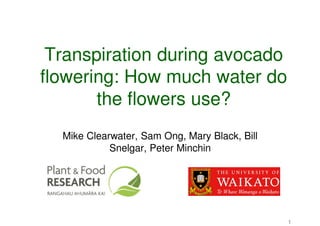Mike Clearwater
- 1. Transpiration during avocado flowering: How much water do the flowers use? Mike Clearwater, Sam Ong, Mary Black, Bill Snelgar, Peter Minchin 1
- 2. Water stress during flowering? âĒ What are the causes of alternate bearing? âĒ Does water stress contribute to poor fruit set? âĒ âFlowers use 80% of the waterâ âĒ Pollen tube growth is sensitive to water potential 2
- 3. Previous studies Whiley et al. (1988) âĒ Inflorescences increase canopy surface area of âFuerteâ by 90% âĒ Estimated that flowers add 13% to tree transpiration Blanke and Lovatt (1993) âĒ Compared the surface morphology and transpiration of leaves and flowers âĒ No estimates of total water use Our hypothesis: âĒ Inflorescences add significantly to tree transpiration, leading to soil moisture deficits and plant water stress 3
- 4. Methods âĒ Hass Avocado in the Bay of Plenty, New Zealand âĒ Flower and leaf removal from whole trees and branches âĒ Measured - inflorescence and leaf area - inflorescence and leaf stomatal conductance - tree and branch transpiration using sap flow - soil moisture, water potentials, photosynthesis âĒ Compared transpiration estimated from surface area and conductance with transpiration measured using sap flow 4
- 5. Measuring inflorescence surface area âĒ Fluidized bed of âBallotini beadsâ âĒ Dip in glue â weigh â dip in beads â reweigh âĒ Area = change in weight added by coating of glass beads 5
- 6. Inflorescence surface area correlated with fresh weight 35 Inflorescence surface area (cm2) 30 25 20 15 10 5 y = 18.84x RÂē = 0.94 0 0 0.5 1 1.5 2 Inflorescence fresh weight (g) 6
- 7. Inflorescence area as a proportion of total surface area 0.6 0.5 Inflorescence area / Total area 0.4 0.3 0.2 0.1 0 Total One-sided inflorescence area inflorescence area 7
- 8. Measuring stomatal conductance âĒ Stomatal conductance was measured using a gas exchange system âĒ Response to humidity was measured as an indicator of the level of stomatal control over transpiration 8
- 9. Stomatal response to humidity 0.35 Stomatal conductance (molm-2s-1) 0.3 leaves 0.25 0.2 0.15 inflorescences 0.1 0.05 0 0.5 1.5 2.5 3.5 Vapour Pressure Deficit (kPa) High humidity Low humidity Low temperature High temperature 9
- 10. Transpiration response to humidity 5 4.5 Transpiration (molm-2s-1) 4 leaves 3.5 3 2.5 2 1.5 inflorescences 1 0.5 0 0.5 1.5 2.5 3.5 Vapour Pressure Deficit (kPa) High humidity Low humidity Low temperature High temperature 10
- 11. Measuring transpiration in the field Heat pulse sap flow probes Paired branches, deflowering and deleafing 11
- 12. Transpiration (L hour-1) Transpiration from sap flow 10 Tree 2 deflowered tree 1 tree 2 8 6 Tree 1 deleafed 4 2 0 300 305 310 315 320 Day of the year 12
- 13. Transpiration (L hour-1) 10 Tree 2 deflowered tree 1 tree 2 8 6 Tree 1 deleafed 4 2 0 300 305 310 315 320 2 Ratio (Tree 1 / Tree 2) Day of the year 1.5 De-flowering = 8% reduction in transpiration 1 0.5 De-leafing = 78% reduction in transpiration 0 300 305 310 315 320 Day of the year 13
- 14. Comparison â Area vs Transpiration Infl. Transp. / Total Transp. 0.2 0.16 0.12 0.08 0.04 y = 0.53x 0 0.1 0.2 0.3 0.4 Infloresecence area / Total area 14
- 15. Soil moisture and plant water potentials âĒ Experiment conducted under mild conditions with adequate rainfall âĒ No significant decline in soil water content over flowering âĒ Plant water potentials and stomatal conductance were unaffected by flower removal, even with heavy flowering 15
- 16. Conclusions âĒ Inflorescences contribute up to 35% of the total transpirational surface area during flowering âĒ Inflorescence surface conductance is half or less that of leaves âĒ Inflorescences contribute up to 15% of the total transpirational water loss during flowering âĒ The flowers do not use 80% of the water, but soil moisture and irrigation management still matter âĒ Soil moisture deficits and tree water stress are unlikely to contribute to alternate bearing if carefully managed âĒ Flower water relations may still be a factor in fruit set 16
- 17. Acknowledgements NZ Avocado Industry Council Jonathan Dixon NZ Foundation for Research, Science and Technology Mike Clearwater m.clearwater@waikato.ac.nz 17
































































